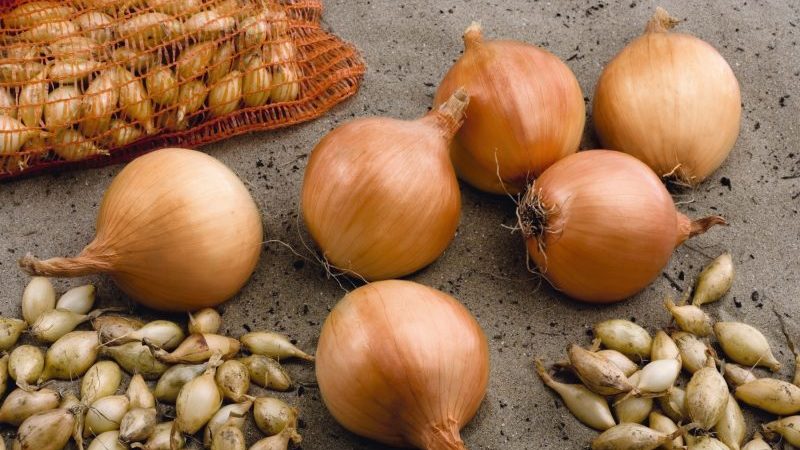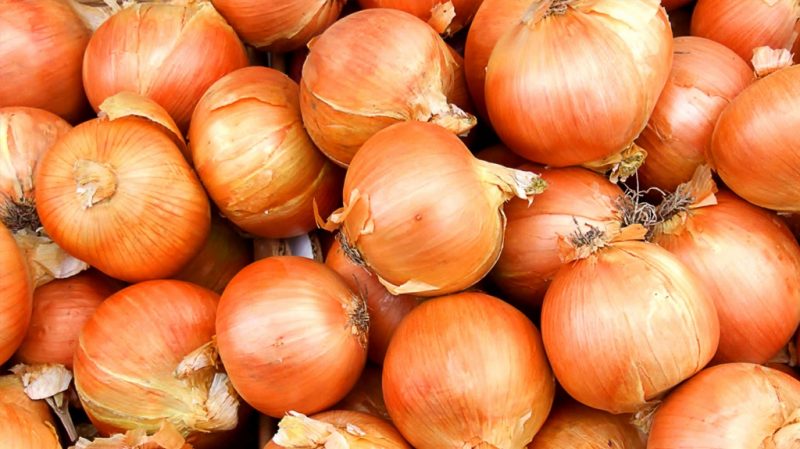An early ripe winter hybrid of Troy onions with a moderately spicy taste
The Troy onion hybrid appeared on the market not so long ago, but vegetable growers have already fallen in love. It ripens quickly, is unpretentious in care, high-yielding, has strong immunity and high keeping quality. Maturation after ripening reaches 100%. More about its merits and rules cultivation let's talk further.
The content of the article
Description of the variety and photo
Thanks to its semi-sharp taste, Troy onions are versatile in use: they are eaten fresh, added to salads, first courses, marinades for meat and fish, and canning.
This winter heterotic hybrid was obtained as a result of breeding work of Dutch scientists of the company "BEJO ZADEN". Troy was included in the State Register of Russia in 2008.
Composition and useful properties
The onion contains:
- vitamins C, E, PP and group B;
- bioflavonoid quercetin;
- phytoncides;
- prebiotic inulin;
- fructose and glucose;
- pectin;
- macro- and microelements: calcium, magnesium, iron, phosphorus and others;
- essential oils;
- alimentary fiber;
- organic acids.
The vegetable is useful for diabetes mellitus, cleanses the blood and normalizes digestion, activates metabolism, and improves blood formation. Onion juice is used as a natural antibiotic: it has general tonic, strengthening and antibacterial properties.
Ripening period and yield
This is a hybrid of early ripening: the crop is harvested 75–80 days after planting. The marketable yield of Troy is 323 kg / ha.
Disease resistance
Troy is resistant to most diseases and pests characteristic of onions:
- downy mildew;
- gray rot;
- bacteriosis;
- onion mosaic;
- onion fly and moth.
Specifications

The plant reaches 45 cm in height, the leaves are tubular, dark green, covered with a thin layer of waxy bloom.
Bulbs are broadly obovate with a medium neck thickness. There are one- and two-primordial. Covered with a light brown husk, weighing an average of 80–90 g.
The pulp is greenish-white, juicy, the taste is semi-sharp.
For which regions is it suitable
The hybrid is included in the State Register with admission to cultivation in the Central Region. At the same time, it adapts well to different climatic conditions and is frost-resistant, therefore it is successfully cultivated practically throughout Russia.
Main advantages and disadvantages
Advantages of the Troy bow:
- early maturation;
- high productivity;
- resistance to shooting, frost, diseases and pests;
- universal application;
- long term storage;
- the possibility of mechanical harvesting.
Disadvantages of a hybrid:
- high cost of seeding;
- the inability to grow from their own seeds;
- cultivation only for the sake of bulbs: not planted for greens.
Differences from others
Comparative table of different hybrids:
| Hybrid | Ripening period | Productivity, c / ha | Taste | Bulb shape | Bulb weight, g |
| Troy F1 | 75-80 days | 323 | Semi-sharp | Broadly obovate | 80–90 |
| Albion F1 | 90-120 days | 167–220 | Semi-sharp | Rounded | 70–100 |
| Spirit F1 | 120-125 days | 78–202 | Semi-sharp | Rounded flat | 47–100 |
| Candy F1 | 85–90 days | 178–355 | Sweet | Broadly obovate | 60–80 |
Planting and growing
To obtain a high-quality harvest, it is important to plant the seedlings in the ground on time and correctly. The material is bought or grown independently from nigella - seeds planted in early spring.
Preparing for landing
To get sevok, seed laid out on a damp cloth and placed in an airtight container for germination for 4-5 days. This will speed up the emergence of seedlings.
To minimize shooting, the sets are hardened. To do this, it is slightly exfoliated, soaked in hot water for 30 minutes, then dipped in cold water. After the bulbs are dried on a paper towel.
Reference. Usually, the seed is soaked in a disinfectant and growth-stimulating solution, but Troy is a hybrid, so it does not need it.
The soil is dug up in advance, cleaned of weeds and plant residues, organic and complex mineral fertilizers are applied. 2-3 days before planting, the soil is watered abundantly and covered with a film so that moisture persists longer.
Ground requirements
Onion Troy is not too picky about the soil composition, but prefers a light nutritious soil with good moisture and air permeability, neutral acidity.
Lime, dolomite flour, chalk or wood ash, which serves as a fertilizer, are introduced into the acidic soil several months before planting.
Timing, scheme and landing rules
Sowing for sevka is carried out in early May according to the scheme:
- Shallow grooves are marked across the beds prepared at a distance of 10–15 cm from each other.
- Seeds are placed in them, deepening by 1 cm and maintaining a distance between them of 1-1.5 cm, followed by thinning to 2-3 cm.
- Sprinkle everything with earth.
Troy onion sets are planted in open ground in the spring (in the Central region - at the beginning of May) or before winter, about three weeks before the onset of frost, when the average daily air temperature drops to + 5 ° C. This usually happens in late September - early November, more precise dates depend on the growing region.
Landing scheme:
- Rakes loosen the previously prepared land on the site.
- Form beds with a ridge height of 15–20 cm at a distance of 60–70 cm from each other.
- Planting furrows are made in them with a depth of 4-5 cm, at the bottom of which sand mixed with wood ash is poured.
- The seedlings are placed in the furrows, deepening at least for the entire “growth” of the bulb, at a distance of 10–12 cm from each other.
- Sprinkle everything with humus and earth, slightly compacting.
When planting before winter, to protect against frost and additional feeding, the soil is mulched with spruce branches, dry straw, sawdust, or covered with agrofibre. The mulch is removed in early spring, after the snow melts.
Growing features
Onions are planted in a well-lit and ventilated area, avoiding lowlands, where the harvest will rot due to the accumulation of melt or rainwater.
For Troy, the same place is not suitable for two years in a row: such a site is used no earlier than after 3-4 years.
Do not plant a hybrid after carrots, herbs, spices, turnips, tomatoes. Best predecessors: cucumbers, cabbage, bell peppers, zucchini, potatoes, beets, peas, radishes.
It is important to choose the right sowing time: with a premature planting in open ground, the onion will begin to grow early and die from frost, if too late, it will not have time to take root.
The nuances of care
This is an unpretentious hybrid, but it needs minimal care, which consists in competent watering, fertilizing, loosening the soil and thinning the seedlings.
Watering mode
Plants are irrigated regularly, but in moderation, avoiding excessive moisture and waterlogging of the soil: this provokes rotting of the bulbs. When watering, they are guided by the condition of the soil: it should be moistened 3-5 cm deep.
Reference. Water at room temperature is poured into the aisles without getting on the sprouts.
A few weeks before harvesting, irrigation is stopped so that the bulbs are finally formed and dried.
Loosening and weeding
They loosen the soil in the aisles one day after watering: this enriches the soil with oxygen and improves moisture circulation.
Planting is weeded every 10-14 days. Around the bulbs, weeds are removed manually, carefully, trying not to damage the surface of the vegetables, and a cultivator or other tools are used in the aisles.
Top dressing
Fertilize the culture several times per season:
- in late April - early May - with organic compounds (rotted manure, compost);
- at the end of June - with liquid mineral products containing sodium and phosphorus.
The land between the rows is watered with infusion of medicinal herbs: nettle, chamomile, dandelion.
Disease and pest control
Due to its good immunity, this hybrid is rarely affected by diseases and insects. If this happens, it is only due to improper care or non-compliance with the landing rules.
If there are signs of disease, the culture is treated with fungicides, insecticides are used for pests.
Harvesting and storage
The readiness of the crop for harvesting is judged by yellowing and lodging of leaves.
How and when to collect
Vegetables are dug out in late June - early July, on a clear sunny day. In large areas, they resort to mechanical harvesting, in small areas, the onions are harvested by hand, pulling them out of the ground, after digging them with a shovel.
Storage features and keeping quality of the hybrid
When the onion is harvested, it is inspected and carefully sorted, discarded, or damaged specimens are put aside for early use. The crop is dried in the sun or under a canopy for two weeks.
Reference. When the tail of the onion becomes completely dry, the vegetables are sent to storage.
Troy is kept in a dark room at a temperature of 0 ... -3 ° C and humidity within 75-90%. The bow is hung in nets, braiding "pigtails", or laid out on a dry surface. If all conditions are met, the crop does not lose its marketability and taste for 4-5 months.
Growing difficulties

When cultivating Troy onions, farmers face some problems:
- rotting of turnips with excessive watering, accumulation of melt or rain water;
- premature germination and abundant growth of green mass with an excess of nitrogen-containing dressings;
- cessation of leaf formation, early formation of bulbs or cessation of growth in case of violation of the rules of agricultural technology and the absence of proper growing conditions.
Tips from experienced gardeners
A few recommendations from experienced vegetable growers:
- When planted before winter, high beds are formed, otherwise the sevok will freeze.
- Carefully align the furrows on the site: this affects the harmony of seedlings and productivity.
- Planting is mulched with natural materials, in extreme cases - with agrofibre. Do not use plastic wrap.
- In the aisles, branches of yarrow, wormwood or tansy are laid out to protect the plantings from insect pests.
Reviews
Reviews of gardeners on the forums confirm the positive characteristics of the hybrid.
Evgeniy, Kursk region: «I have been planting Troy for 6 years in a row, the hybrid is excellent. I always buy ready-made sets and plant them before winter. It has never happened before that the harvest was small or spoiled. A couple of damaged bulbs do not count. I keep the vegetables in the cellar, they are there without problems until the New Year. "
Anna, Oryol region: “I usually don't work well with winter onions: I seem to plant it in mid-October, but it still manages to germinate, and then freezes and dies. Last year I tried to plant Troy, and everything worked out. I don't even know what the matter is: either I guessed it over time, or the bow itself is excellent. In general, I liked everything: the harvest was large with minimal care, the taste of vegetables was mild. "
Conclusion
Troy is a winter onion hybrid, but it is also planted in the spring. The culture is resistant to diseases and pests, does not require special care, pleases with consistently high yields and is suitable for cultivation in almost all regions of Russia.A shelf life of up to five months and a semi-sharp taste of the bulbs make them versatile in cooking.